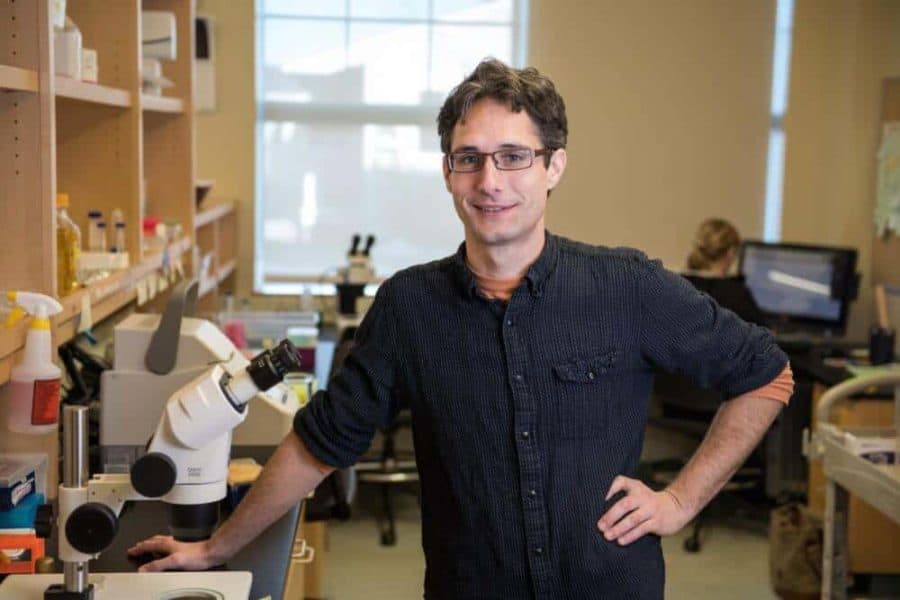Exactly when does old age begin? Which health markers best predict who will live a long and healthy life versus a life spent in poor health?
Developing metrics to help answer these questions and to understand the tradeoffs between lifespan and health span is the subject of a recent paper by MDI Biological Laboratory scientists in Journals of Gerontology: Biological Sciences, a publication of the Gerontological Society of America.
The authors studied various parameters of health in short-lived strains of the roundworm, C. elegans, with the goal of developing an empirical definition of the onset of old age, and of teasing out which health markers are most predictive of a long and healthy life.
With the development of new genetics tools, scientists are getting closer to developing therapies to extend human lifespan, but the effect of such therapies on health span (the proportion of life spent in good health) is unclear. While it used to be thought that therapies to extend lifespan would also extend health span, new research is showing that may not always be true.
The growing number of anti-aging therapies on the horizon creates a need for the development of new parameters to assess healthy aging. Instead of striving to only to prolong longevity, as has been the case in the past, the use of such tools will allow scientists to focus their efforts on lifespan-enhancing therapies with the greatest positive effects on health.
“All anti-aging interventions aren’t created equal,” said post-doctoral researcher Jarod Rollins, Ph.D., one of the study’s lead investigators. “A recent study in C. elegans found, for instance, that the proportion of life spent in a frail state is longer in long-lived mutants than in wild-type animals. Our research is aimed at developing tools to help scientists assess the effect of lifespan-enhancing interventions on health span.”
The molecular mechanisms of aging are a focus of research at the MDI Biological Laboratory, located in Bar Harbor, Maine, which is pioneering new approaches to regenerative medicine focused on the development of drugs to increase healthy lifespan by enhancing the body’s innate ability to repair and regenerate lost or damaged tissues and organs.
Rollins works in the laboratory of Aric Rogers, Ph.D., the lead author of the study, in the institution’s Kathryn W. Davis Center for Regenerative Biology and Medicine.
C. elegans is a popular model in aging research because its short lifespan of only two to three weeks allows scientists to quickly assess the effects of anti-aging interventions, including genetic manipulation and drug therapies. The tiny, soil-dwelling roundworm also has other advantages for research: it shares many of its genes with humans and its health markers roughly correspond to those in humans.
One marker that the MDI Biological Laboratory scientists found to be predictive of a healthy lifespan in C. elegans was movement speed. Movement speed corresponds to walking speed in humans, which studies have found to be an accurate predictor of longevity. One of the scientists’ next steps will be to further develop movement speed as a marker for assessing the effect of anti-aging interventions in C. elegans.
“As science closes in on the mechanisms underlying aging, the tradeoffs between lifespan and health span become a greater cause for concern,” said Kevin Strange, Ph.D., president of the MDI Biological Laboratory. “The scientists in the Rogers laboratory are at the forefront of developing metrics to assess the impact of anti-aging interventions on quality of life.”



NATURES WRINKLE WRECKER
Eliminate wrinkles forever! Don’t just try to repair your wrinkled old skin; replace it with brand new beautiful skin.
In Fair Haven, NJ there is a modest home owned by Dr’s. Phineas and Philomena Pfluge. They will shortly become world renowned herpetologists. In their mostly illegal sub-basement (fondly referred to as The Snake Pit) they have a complete research laboratory. Complete laboratory really is defined as a hoarder’s paradise consisting of massive quantities of stuff that most normal folks would chuck out.
One day Phineas shouted “EUREKA” (All really great discoveries are announced by at least one EUREKA). Then came “Philomena I’ve got it!’’. The elusive gene they have been searching for is the one that prompted snakes to shed their old skin and replace it with brand new skin. The search for this gene was initiated when Philomena first discovered “crow’s feet wrinkles” attacking her face whenever she smiled.
Now she simply lathers her whole body with their new (patent
pending) Wrinkle Wrecker Lotion and in 15 days she sheds her old
skin and emerges in her new beautiful un-wrinkled skin. Depending on use this new skin should stay unwrinkled for at least one year. You may repeat this process as frequently as required to keep the wrinkles away.
The FDA has withheld its approval because of two minor negative
reactions:
1. Some users report an adverse side effect which urges them to eat live Furry rodents frequently. If this is done in the privacy of your home – why should the FDA interfere and restrict your freedom of choice?
2. Each use causes you to grow approximately 3 inches. Perhaps the FDA is prejudiced against women of height. Philomena has done this several times and now is seven feet eight inches tall. She has been negotiating player contracts with several professional basketball teams. Her skin is perfect, and her crow’s feet have flown away.
You may obtain a 1 gallon drum of this skin renewal lotion under the counter at most drug stores for the modest sum of $247.00.
Dr’s. Phineas and Philomena Pfluge are continuing their research into several other avenues of life enhancing products.